If you’re looking to add a challenging arm balance pose to your yoga practice, crane pose, also known as bakasana, is a great option. However, it requires proper technique and preparation to ensure safety and success. In this section, we will guide you through the steps to master crane pose while focusing on balance, stability, and alignment.
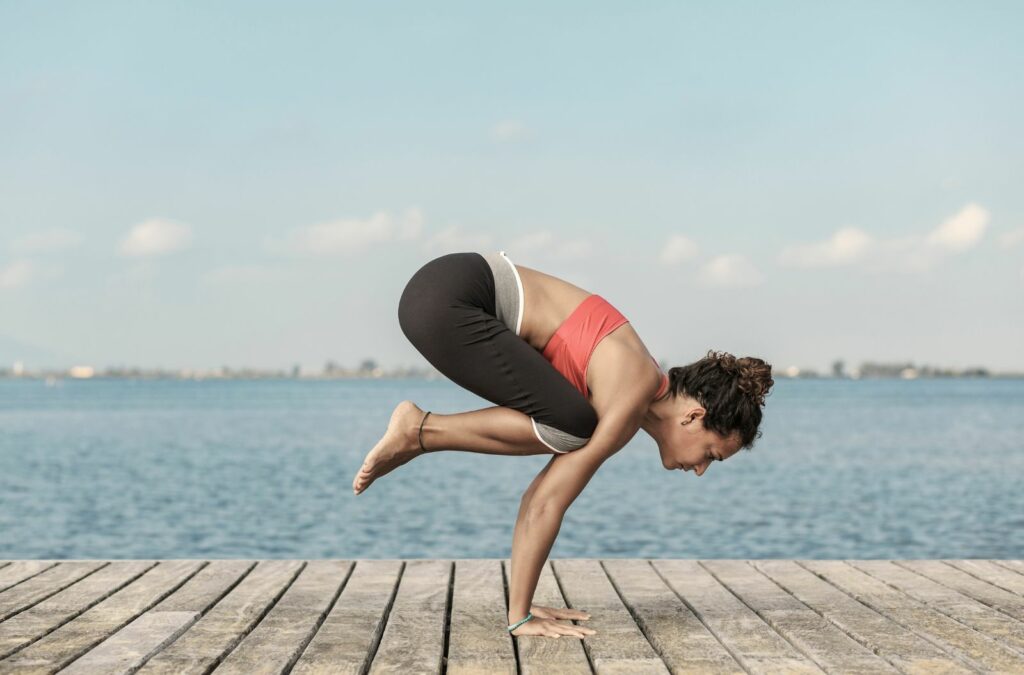
Key Takeways
- Crane pose requires balance, strength, and concentration.
- Proper preparation and technique are crucial to achieving balance and safety.
- Strengthening your wrists, arms, and core muscles is key to safely practicing crane pose.
- Engaging your core, keeping your arms straight, and gradually lifting one foot off the ground will help achieve balance and stability.
- Modifications and props can assist beginners in finding their balance, while progressions allow for advanced variations of the pose.
Understanding the Crane Pose
Before we dive into the details of how to do crane pose, also known as bakasana, let’s take a moment to understand this popular yoga pose and its relation to crow pose. Crane pose is an arm balancing yoga pose that requires both strength and balance. It is similar to crow pose, but in crane pose, the arms are straight and the upper arms are closer to the armpits.
Crane pose offers numerous benefits, including strengthening the arms, wrists, and upper body, improving balance and coordination, and building core strength. It can also help to improve focus and concentration, making it a rewarding addition to any yoga practice.
Arm balances like crane pose can be challenging, so it’s important to approach the pose with patience and a willingness to learn and grow. With consistent practice and proper alignment, you can master this powerful asana.
As we delve further into the details of crane pose, keep in mind the benefits and challenges of this arm balancing yoga pose, and remember to approach it with a sense of curiosity and respect for your body.
Preparing Your Body for Crane Pose
Before attempting crane pose, it’s important to prepare your body for the arm balance. This pose requires significant strength in your wrists, upper arms, and core muscles, so it’s crucial to ensure your body is ready for the challenge. Proper alignment is also key, especially in poses like plank pose, which can help you build the necessary arm strength and wrist flexibility.
Start by warming up your wrists with gentle circular movements, flexing them forward and backward. This will help prevent any strain or injury to your wrists during the pose. You can also practice poses like downward facing dog and dolphin pose to build initial strength in your upper arms and shoulders.
As you progress, focus on building core strength through poses like boat pose and crunches. Engage your core muscles in each pose, and practice holding for longer periods to build endurance. Additionally, work on strengthening your triceps, biceps, and forearms with exercises like push-ups and dumbbell curls.
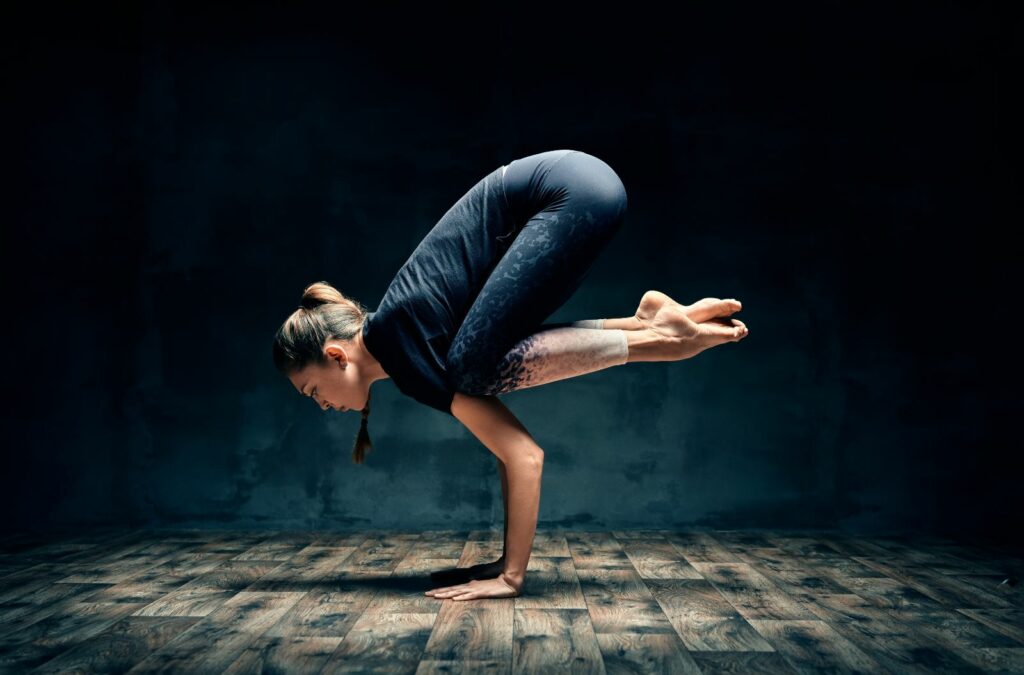
To prepare for crane pose specifically, practice holding garland pose (malasana) for longer periods while shifting your weight forward toward your toes. This will help build the necessary arm and upper body strength, as well as develop the balance and stability needed for crane pose.
Remember to listen to your body and take breaks as needed. Don’t push yourself too hard too soon, as this can lead to injury. Instead, gradually build up your strength and endurance over time.
“Proper preparation and alignment are crucial for safely and successfully practicing crane pose, or any arm balance for that matter. Take the time to build strength in your wrists, upper arms, and core muscles, and maintain proper form in poses like plank pose to ensure a rewarding yoga experience.”
Getting Into the Crane Pose
To begin, assume the malasana or garland pose by squatting on your mat with your feet slightly wider than your hips. Place your hands on the mat in front of you, shoulder-width apart. Be sure to keep your elbows bent and your upper arms close to your armpits.
Shift your weight forward and lean your torso slightly forward as well. While doing this, lift one foot off the ground, keeping your toes pointed and your gaze fixed on a point on the floor in front of you. Then, gradually lift the other foot off the ground and balance your body weight on your hands.
It’s essential to maintain a strong and stable core while lifting your feet. Doing so will help you find your balance and prevent strain on your lower back.
When placing your hands on the mat, ensure that they are shoulder-width apart and fingers are spread wide for stability. Your hands should be firmly rooted into the mat, and your fingers should point toward the top of your mat. This ensures that your arms are straight and that your bodyweight is evenly distributed on your hands.
Remember to keep your gaze fixed on the floor in front of you to maintain balance. If you find it challenging to lift both feet off the ground at once, start by lifting one foot and gradually progressing to lift the other.
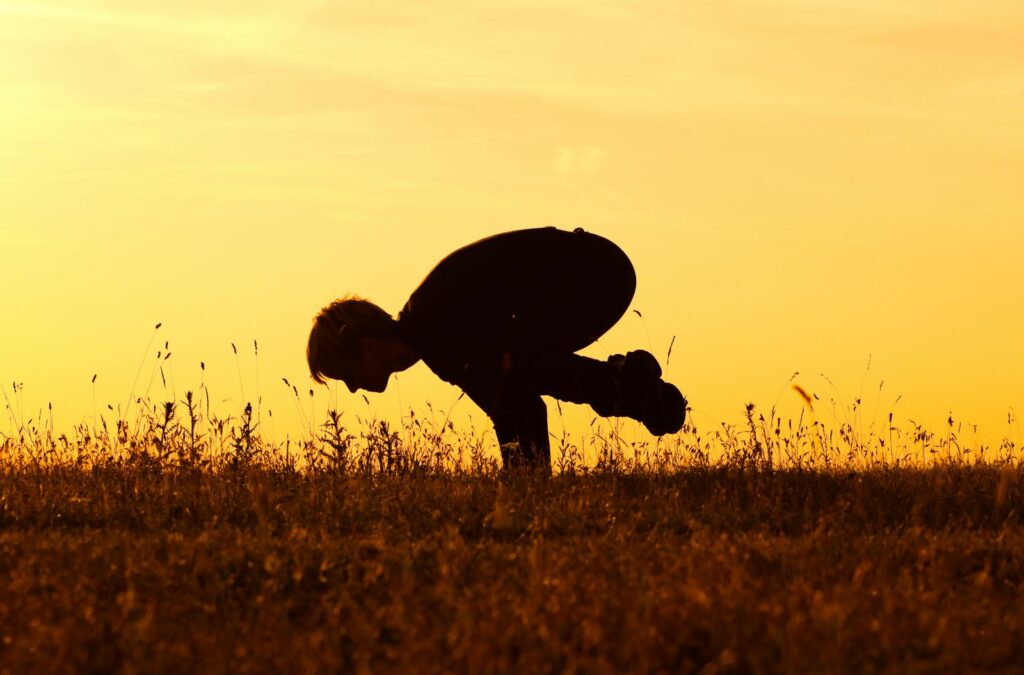
As you practice crane pose, pay attention to your body’s alignment. Keep your lower back lengthened and avoid sinking into your shoulders. Keep your elbows bent and your upper arms close to your armpits to maintain proper alignment.
Finally, remember to breathe deeply and maintain a steady breath throughout the pose. With practice and dedication, you’ll be able to find balance and stability in crane pose.
Finding Balance and Stability in Crane Pose
As mentioned, crane pose requires balance, strength, and concentration. To achieve this, it’s important to engage your core muscles and keep your arms straight. Once you feel comfortable in the basic asana, you can gradually lift one foot off the ground.
Remember to practice bakasana regularly, integrating it into your yoga routine. Consistency is key to building core strength and achieving balance in this pose.
To properly practice crane pose, keep your arms straight and shoulder-width apart. Make sure your hands are firmly planted on the mat, and your knees are resting on the back of your upper arms.
As you lift one foot off the ground, maintain a steady flow of breath and focus on your core strength. Keep your gaze forward, and hold the pose for several breaths before lowering your foot and repeating on the other side.
Remember, it’s important to find your own balance and avoid forcing your body into the pose. If you need to modify the pose, try placing a block under your forehead or raising your hips slightly.
By practicing crane pose regularly and focusing on core strength, you can gradually lift your feet off the ground and explore variations of this challenging arm balancing yoga pose.
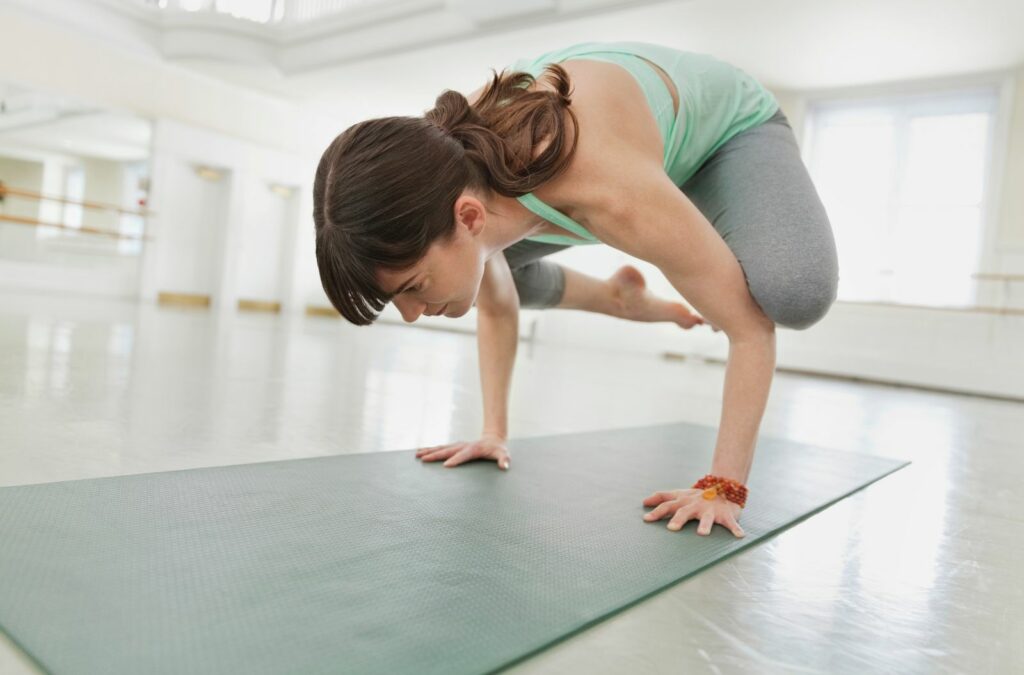
Modifications and Props for Crane Pose
If you find crane pose challenging, don’t worry! There are modifications and props to help you find your balance and build your arm strength. One helpful prop is a block. You can place a block on the floor and use it to support your body weight as you work on the pose. This can be especially useful if you’re not yet able to lift your feet off the ground.
Another modification is to start with your knees on the ground. This takes some of the weight off your arms and wrists, allowing you to focus on building your arm strength. As you get stronger, you can gradually lift your knees off the ground and work towards the full pose.
Strengthening your core is also important for mastering crane pose. You can practice plank pose to help build your core muscles. This will improve your balance and stability in crane pose.
Remember, it’s important to listen to your body and not push yourself too hard. If you feel any pain or discomfort, come out of the pose and take a break. With regular practice and the use of helpful modifications and props, you can strengthen your arms and build your balance in crane pose.
Crane pose can be challenging, especially for beginners. Here are some common mistakes to avoid and tips to help you find your balance:
Weak Arm and Wrist Strength
Arm and wrist strength are crucial for supporting your body weight in crane pose. If you find yourself struggling, try incorporating exercises that target these areas into your regular yoga practice. Push-ups, wrist curls, and reverse wrist curls are great options for building strength.
Hands on the Floor
When placing your hands on the floor, make sure they are shoulder-width apart and spread your fingers wide. This will help distribute your weight evenly and provide a stable base for your body.
Knees on the Back
Placing your knees on the back of your arms can help you find balance in crane pose. However, it’s important to engage your core and avoid putting too much pressure on your elbows. Keep your gaze forward, and slowly lift one foot off the ground when you feel stable enough to do so.
Finding Your Balance
Balance is key in crane pose, but it requires practice and patience. Focus on engaging your core muscles and keeping your arms straight. If you feel yourself falling out of the pose, try bringing your feet back to the ground and starting again. Remember, it’s okay to fall – it’s all part of the practice.
| Tip: Visualize yourself lifting your body higher and finding your balance in crane pose. With practice, you’ll be able to hold the pose for longer periods of time. |
Progressing in Crane Pose
As you become more comfortable in crane pose, you can start to progress by lifting your body higher and exploring different variations. Remember to focus on maintaining balance, engaging your core, and keeping your arms straight.
One way to progress in crane pose is to lift your body higher off the ground. As you press the palms into the mat, engage your core muscles and lift your knees off the ground. Slowly lift your feet off the ground, one at a time, and hold the pose for a few breaths.
Another way to progress is to lift your body higher while keeping your knees on the ground. This helps you focus on building arm and wrist strength while still engaging your core. As you press your palms into the mat, lift your buttocks up and press your knees into the back of your upper arms.
You can also explore different variations of crane pose, such as twisting or transitioning into other arm balances. Remember to listen to your body and only progress at a pace that feels comfortable for you.
As you progress in crane pose, it’s important to feel the muscles working in your body. You should feel your core muscles engaged, your arms and wrists working to support your body weight, and your legs active as you lift them off the ground.
Remember to practice regularly and not to be discouraged by setbacks. With patience and dedication, you can master crane pose and progress to even more challenging arm balancing poses.
Keep lifting your practice higher by pressing into your palms, engaging your core, and focusing on lifting your feet off the ground in crane pose.
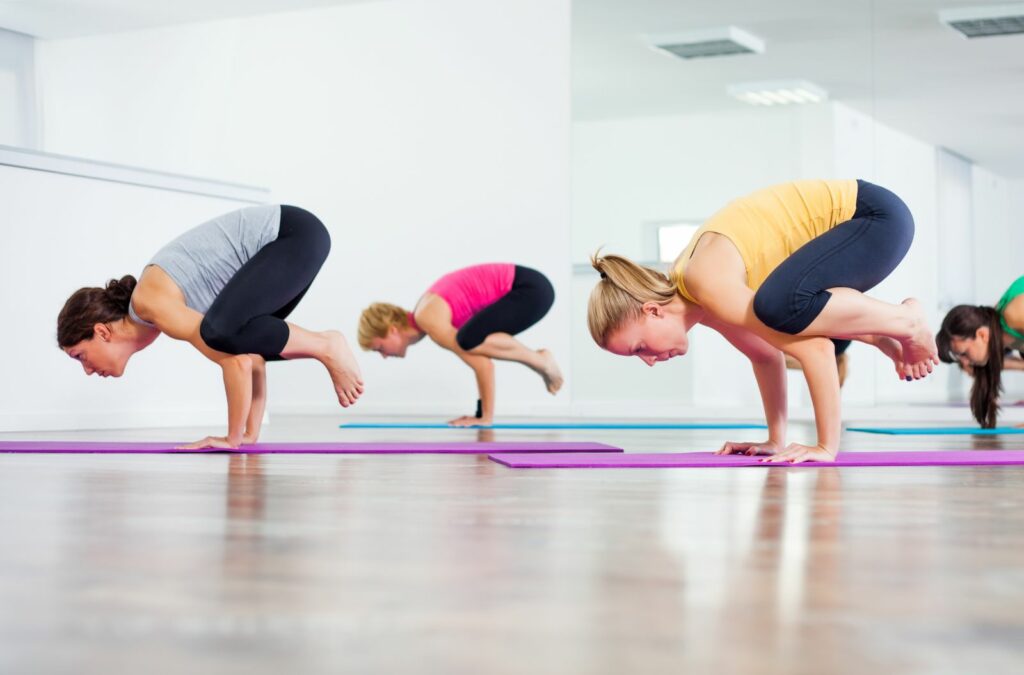
Conclusion
Practicing crane pose, also known as bakasana, requires patience and dedication. By following the step-by-step guide provided in this article, focusing on understanding the pose, preparing your body, and finding balance and stability, you will be well on your way to mastering this challenging arm balancing yoga pose.
Remember, it’s important to listen to your body and avoid pushing yourself too hard. Taking the time to build wrist and arm strength, maintaining proper alignment, and engaging your core muscles will help you achieve success in the practice of bakasana.
Benny Martica
Benny Martica, a certified Hatha Yoga teacher based in Argentina, is a dedicated and passionate advocate of yoga’s transformative power. With a deep commitment to mindfulness and holistic wellness, she empowers her students to find balance and well-being through the practice of yoga. . Her mission is to inspire others on their path to personal growth and self-discovery.

